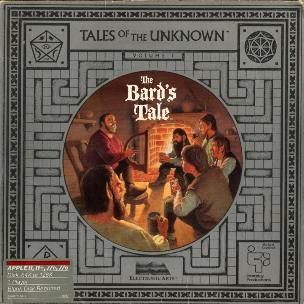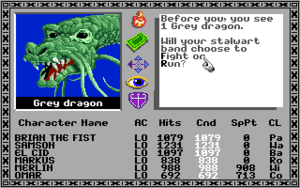The Bard's Tale (1985 video game) facts for kids
Quick facts for kids The Bard's Tale |
|
|---|---|
 |
|
| Developer(s) | Interplay Productions Krome Studios (remaster) |
| Publisher(s) | Original:
|
| Designer(s) | Michael Cranford |
| Series | The Bard's Tale |
| Platform(s) | Amiga, Amstrad CPC, Apple II, Apple IIGS, Atari ST, Commodore 64, DOS, Macintosh, NES, PC-98, Windows, Xbox One, ZX Spectrum |
| Release date(s) | Apple II
2018–2019 |
| Genre(s) | Role-playing |
| Mode(s) | Single-player |
The Bard's Tale is an exciting fantasy role-playing video game. It was created by Michael Cranford for the Apple II computer. The game was made by Interplay Productions in 1985. Electronic Arts helped share it with players.
Over time, The Bard's Tale was made available on many other computers. These included the Commodore 64, Apple IIGS, Amiga, and even the NES. This game became so popular that it started a whole series of The Bard's Tale games and books.
In 2018, a new, updated version of the game was released for Windows computers. An Xbox One version followed in 2019.
Contents
Story of the Game: Saving Skara Brae
The game's story begins in a peaceful town called Skara Brae. An evil wizard named Mangar the Dark has taken over. He brought scary creatures into the town. Mangar also cast a spell of "Eternal Winter," trapping Skara Brae.
One night, all the town's guards disappeared. Who was left to fight back? Only a small group of young heroes. These included brave Warriors, new Magic Users, Bards, and clever Rogues.
You play as the leader of this group. Your goal is to defeat Mangar and save Skara Brae. Luckily, you have a Bard with you. They can sing songs about your adventures if you survive!
Your Adventure Begins: Forming a Party
In the game, you create a team of up to six characters. To win, your characters need to become stronger. You do this by defeating monsters in dark dungeons. You also find special items and gather important information.
The town of Skara Brae is like a big maze. It has many buildings and streets. Some streets are blocked by gates or magical statues. The main city gates are covered in snow, so you can't leave that way.
Exploring Skara Brae's Special Places
Certain buildings in Skara Brae are very important:
- The Adventurer's Guild: This is where you start your journey.
- Garth's Equipment Shoppe: Here you can buy gear for your heroes.
- The Review Board: This secret place is where your characters can level up.
- Taverns and Temples: These offer places to rest or gather clues.
The game is full of mazes. These include cellars, sewers, and old catacombs. They are filled with monsters and puzzles. Some areas are guarded by magical statues that come to life!
Dungeons to Explore
To defeat Mangar, you must explore several dangerous dungeons:
- The Wine Cellar and Sewers: Your first adventure starts in a tavern's wine cellar. It connects to the Sewers of Skara Brae. From the sewers, you can reach Mangar's Tower, but you'll need a key to get in. You'll find clues about a "Mad God" here. To find the cellar, you need to order wine at a specific tavern.
- The Catacombs: These are dark tunnels filled with undead creatures. You can only enter if you know the name of the Mad God. At the deepest level, you must defeat a powerful Spectre to get a special eye.
- Baron Harkyn's Castle: If you have the eye from the Catacombs, a statue in this castle can teleport you to a new area of Skara Brae. This area leads to the next dungeon.
- Kylearan's Tower: You can only reach this tower through Harkyn's Castle. Inside, you'll meet Kylearan the Archmage, who is friendly. He gives you the key to Mangar's Tower.
- Mangar's Tower: This is the final dungeon. It has five levels. You need to find several special items from other dungeons to defeat Mangar. Once you find a key inside, you can enter Mangar's Tower directly from the city.
How to Play: Gameplay Basics
The Bard's Tale is a classic dungeon crawl game. Your main goal is to gain experience and improve your characters' skills. You do this mostly by fighting enemies and monsters. As you explore mazes and solve puzzles, you'll find or buy better weapons and armor.
Creating Your Heroes
When you start the game, you can create up to six characters. You choose from different classes:
- Bard
- Hunter
- Monk
- Paladin
- Rogue
- Warrior
- Magician
- Conjurer
As your magic users gain experience, they can become even more powerful. Conjurers can become Sorcerers, and Magicians can become Wizards. If a magic user masters all spells, they can become an "Archmage."
The Unique Bard and Magic
One special part of the game is the Bard. Their magical songs act like long-lasting spells. These songs can make your party stronger, like boosting their armor or making them attack faster. Some puzzles in the game can only be solved using a Bard's songs. Each song plays its own music, some of which are famous classical tunes.
Magic users can also change their classes. The game has 85 different spells. In older versions, you had to type a four-letter code for each spell. Newer versions let you choose from a list with a mouse.
Combat in the Game
When you fight enemies, it's a turn-based system. This means you and the enemies take turns performing actions. The game describes the combat with text, rather than showing characters moving on a map. After you win a fight, all surviving party members share the money and experience points.
Game's Story Book: The Cluebook
In 1986, the game's publisher, Electronic Arts, released a special book. It was called a cluebook. This book added more characters and background to the game's world.
The cluebook is written like a journal. It's from the point of view of Lord Garrick. He and his party are trapped in Skara Brae. They try to defeat Mangar, exploring dungeons and solving puzzles. But before they can face Mangar, their Rogue steals important items and leaves.
How the Game Was Made
Michael Cranford came up with the idea for The Bard's Tale. He also designed and programmed it. Brian Fargo, who started Interplay, helped with the design. David Lowery created the graphics, and Lawrence Holland composed the music.
Cranford said that the game's design was inspired by his and Brian Fargo's experiences playing Dungeons & Dragons. They wanted to make a game with better graphics and sound than other games of its kind.
There were some disagreements during the game's creation. However, the people involved, including Cranford, Fargo, and Rebecca Heineman (who helped with programming), have since become friends. They don't hold grudges about past issues.
When Brian Fargo started making The Bard's Tale IV: Barrows Deep years later, Cranford was invited to help. Rebecca Heineman also offered to create updated versions of the first three games for modern computers.
The Bard's Tale Family: Sequels and More
The Bard's Tale was a huge success. It sold many copies and was loved by critics. This led to two official sequels and a "Construction Set" game.
- The Bard's Tale II: The Destiny Knight (1986)
- The Bard's Tale III: Thief of Fate (1988)
- The Bard's Tale Construction Set (1991)
Later, all three classic games were put together in a collection called The Bard's Tale Trilogy.
Why the Name Changed
The series was originally going to be called Tales of the Unknown. The first game was even titled "Tales of the Unknown, Volume I" on its box. But because The Bard's Tale was so popular, Electronic Arts decided to use that name for the whole series.
What was planned as The Bard's Tale IV became a different game called Dragon Wars (1989). This happened because the game creators and publisher had some legal issues.
A New Kind of Bard's Tale
In 2004, a new company called InXile Entertainment released a game also called The Bard's Tale. This game was very different. It was an action RPG that made fun of traditional fantasy games. It wasn't a direct sequel to the old games. It used the name because of a legal loophole. However, InXile couldn't use the original story, characters, or places from the classic trilogy.
In 2015, Brian Fargo announced plans for a true sequel, The Bard's Tale IV. This game was funded by fans and released in 2018. It continues the story of the original trilogy but has updated gameplay.
The Mage's Tale was a spin-off game released in 2017. It uses virtual reality technology.
Updated for Today: Remastered Edition
During the creation of The Bard's Tale IV, InXile teamed up with Rebecca Heineman to update the original trilogy. This "Remastered Edition" was released on August 14, 2018.
The Remastered Edition basically rewrote the original games. It kept the story and gameplay ideas but updated the graphics, sound, and how you play the game. They also fixed many bugs. The goal was to make the games work well on modern computers and feel more consistent.
The remastered trilogy was also released for Xbox One in 2019.
Books Based on the Game
A series of novels based on The Bard's Tale were published in the 1990s. Even though the books didn't follow the game's story closely, they showed how popular the Bard's Tale name had become.
Some of these books include:
- Castle of Deception, by Mercedes Lackey and Josepha Sherman (1992)
- Fortress of Frost and Fire, by Mercedes Lackey and Ru Emerson (1993)
- Prison of Souls, by Mercedes Lackey and Mark Shepherd (1994)
- The Chaos Gate, by Josepha Sherman (1994)
- Thunder of the Captains, by Holly Lisle and Aaron Allston (1996)
- Wrath of the Princes, by Holly Lisle and Aaron Allston (1997)
- Escape from Roksamur, by Mark Shepherd (1997)
- Curse of the Black Heron, by Holly Lisle (1998)



